INTRODUCTION
The peach (Prunus pérsica L.) cv. Dorado is characterized by a yellow epidermis, with a light red pigmentation, gold-yellow mesocarp with red colorations around the endocarp, trichomes on the exocarp, velvety skin, and mesocarp adnate to the endocarp; additionally, it has a high sugar content and can reach up to 150 g in weight. All of these characteristics make the peach highly desirable for fresh consumption and for industrialization (Campos, 2013). Of the deciduous fruit trees, the peach is very important for Colombian agriculture, particularly in the Department of Boyaca because of its optimal edaphoclimatic characteristics, vocation and productive expertise (Puentes et al., 2015). However, the peach cv. Dorado is highly perishable and has a short postharvest life (11 d in the conditions evaluated by Africano et al., 2016), which limits its commercialization. This may be due to the fact that the peach is a climacteric fruit (Africano et al., 2016), which means there is an accelerated increase in the ethylene production and the respiratory rate associated with ripening (Brackmann et al., 2013).
Ethylene is the hormone responsible for triggering physiological, biochemical and molecular processes that guarantee fruit ripening (Binder, 2008; Balaguera-López et al., 2014a) by bonding to a group of protein receptors mainly located on the membrane of the endoplasmic reticulum (Chen et al., 2005; Serek et al., 2006). Ethylene allows fruits to reach optimal organoleptic characteristics for consumption; however, it is also in charge of inducing senescence, which causes agricultural products to loose nutritional and commercial value (Bapat et al., 2010; Balaguera-López et al., 2014a).
To reduce the postharvest losses of the peach cv. Dorado, it is necessary to understand the processes associated with ethylene during ripening, as a foundation for various technologies that reduce the biosynthesis and action of ethylene. Zhang et al. (2012) stated that the ethylene regulation of peach ripening has been thoroughly studied using biochemical, molecular and genetic techniques. However, several reviews on ethylene biosynthesis suggest that the exact role of ethylene in the ripening process is not yet fully understood (Bapat et al., 2010; Barry and Giovannoni, 2007) and that the knowledge gap is even greater in peach genotypes grown in the high tropics. In this regard, several studies have used the application of ethylene and 1-methylcyclopropene (1-MCP) on fruit (Zhang et al., 2012; Yang et al., 2013; Balaguera-López et al., 2016; Barreto et al., 2017).
1-MCP is the main ethylene inhibitor (Watkins, 2006), taking up the place of the ethylene receptors irreversibly and, thus, blocking the transduction chain of the signals responsible for the genetic expression related to the response to this hormone (In et al., 2013). The effect of 1-MCP on the physiological and biochemical processes of peach ripening has been evaluated in several studies with conflicting results: in some studies, 1-MCP blocked ethylene biosynthesis, but in others, it was ineffective (Dal Cin et al., 2006; Hayama et al., 2008; Tadiello et al., 2016; Wang et al, 2017). Liu et al. (2005, 2015) and Wang et al. (2017) found that 1-MCP delayed peach fruit ripening. However, Kluge and Jacomino (2002) and Tonetto et al. (2007), among others, suggested that the utility of 1-MCP is limited because it can delay peach ripening only when it is applied during the pre-climacteric state. Therefore, this study aimed to evaluate the effect of 1-MCP and ethylene, both individually and combined, on the postharvest behavior of the peach fruit cv. Dorado in order to understand ethylene-dependent ripening and the commercial potential of 1-MCP for extending the postharvest life and commercial period of this fruit.
MATERIAL AND METHODS
The peach (Prunus persica L.) cv. Dorado fruits came from a peach commercial crop located in Cerinza, Boyaca. The fruits were harvested with 100% green epidermis -0% yellow-red, with color values L*=62.54, a=-4.58 and b=40.81. They had a homogeneous size and good phytosanitary conditions and were taken to the postharvest laboratory of the Universidad Pedagógica y Tecnológica de Colombia (UPTC), Duitama campus, where the experiments were conducted.
Four treatments in a completely random experiment design were evaluated: 1-MCP, 1-MCP+ethylene, ethylene and a control; each treatment was replicated four times, for a total of 16 experiment units, each one composed of approximately 1,000 g of fruit. One day after harvest, the fruits were washed and disinfected with a 1% sodium hypochlorite solution, and the treatments were immediately applied. For the 1-MCP (EthylBloc®) treatment, a 0.35 mg L-1 1-MCP solution was used, in which the fruits were submerged for 5 min, the adapted methodology of Choi et al. (2008). For the ethylene treatment, fruits were submerged in 1000 mg L-1 of ethephon (Ethrel® 48 SL, Bayer Crop-Science) for 5 min and dried at room temperature; for the 1-MCP+Ethylene treatment, the ethylene was applied 7 d after the 1-MCP application. Finally, the fruits were stored on trays of expanded polystyrene at room temperature (16 ±2°C; relative humidity of 70±12% at average). The variables were measured at 1, 4, 7, 12, 16 and 19 days of storage (DOS), until the fruits lost their commercial quality. The respiratory rate (RR; mg CO2 kg-1 h-1) was estimated by taking 600 g of fruit approximately and placing them in VER BC-2000 2000 cm3 hermetic chambers (Vernier Software & Technology, Beaverton, OR) for 5 min and by determining the concentration of CO2 with a VER CO2-BTA sensor and the LabQuest2 interface system (Vernier Software & Technology, Beaverton, OR). The weight loss was calculated by measuring the fresh mass (the same fruits used for RR) in an Accu-lab VIC 612 electronic scale, 0.01 g precision (Sartorius Spain S.A., Madrid). To determine the color index (CI), the equation (1) reported by Balaguera-López et al. (2014a) was used; the system parameters, CIELab "L", "a" and "b", were obtained from three readings in the equatorial zone of two fruits per replication, using a Minolta CR 300 digital colorimeter (Minolta Co., Tokyo).
IC= (1000 x a*)/(L* x b*) (1)
The fruit firmness was estimated using a PCE-PTR200 digital penetrometer (PCE-Ibérica SL, Albacete, Spain) with 0.05 N approximation, and the soluble solids (SS) were measured using a Hanna HI 96803 digital refractometer (Hanna Instruments, Woonsocket, RI) with a 0-85% range and 0.1 °Brix precision. For the total acidity (TA), which was expressed as the percentage of malic acid, the volume data of NaOH, using 1 g of fruit juice, taken to 25 mL with distilled water, and adding two drops of phenolphthalein in a base-acid titration, were used. The maturity ratio (MR) was determined as the quotient between SS and TA. For the destructive measurements (firmness, SS, TA, MR), one fruit was used in each sample for experimental unity.
The obtained data were analyzed with normality (Shapiro-Wilk) and homogeneity (Levene test) tests; subsequently, an analysis of variance and a Tukey range test (P<0.05) were conducted; the statistics software R v 3.4.2 was used.
RESULTS AND DISCUSSION
All sampling points showed statistically significant differences (P<0.05) in the respiration rate; the treatment that resulted in the highest respiratory rate was ethylene, followed by the control, although they were not significantly different. These two treatments were significantly different from the treatments with 1-MCP. Additionally, the treatment with ethylene and the control increased the respiration rate notably after 12 d of storage, reaching values of 60.89 and 59.01 mg CO2 kg-1 h-1, respectively. On the contrary, the application of 1-MCP resulted in a smaller respiration rate over the storage period, showing a prolong increase from day 7 to 19, with a value of 50.13 mg CO2 kg-1 h-1; this result was similar to that observed in the fruits treated with 1-MCP+ethylene (Fig. 1).
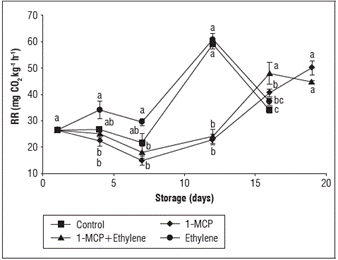
Figure 1 Effect of ethylene and 1-methylcyclopropene on respiratory rates (RR) of peach cv. Dorado fruits during storage. Means followed by different letters on the same sampling day showed statistically significant differences according to Tukey's test (P<0.05). Vertical bars on each mean indicate the standard error (n = 4).
The respiratory rate in climacteric fruits, including peach, depends on ethylene. Zhang et al. (2012) found that ethephon can accelerate energy production, glycolytic metabolism and ethylene biosynthesis, which may accelerate respiration in the tissue. In apple fruits, Yang et al. (2013) noted that the application of ethylene increased the respiratory rate, whereas 1-MCP decreased it, similar to that observed in this research.
The results showed that the application of 1-MCP decreased the respiration rate, perhaps because it blocks ethylene cellular receptors (Watkins, 2006). Similar studies have suggested that peach fruits reduce their respiratory rate in the presence of 1-MCP, thus, decreasing the intensity of physiological processes (Steffens et al., 2009; Wang et al., 2017). Likewise, Valero et al. (2004) showed that applications of 1-MCP delayed the climacteric increase in plums, whereas treatments with ethylene accelerated it. Therefore, the respiratory rate is closely related to the climacteric rate; hence, the application of 1-MCP is a viable alternative to prolong peach fruit quality. On the other hand, the increase in the respiratory rate shown by the fruits treated with 1-MCP may have been due to a rise in the amount of ethylene receptors synthetized by the tissue (Serek et al., 2006). Despite this, the addition of ethylene after 1-MCP did not increase the respiration, as compared to the fruits treated with 1-MCP, possibly because the low levels of ethylene in the tissues were sufficient to bind to the few existing receptors (through the effect of the 1-MCP) and induce an increase in the respiratory rate of the peach fruits.
For firmness, the peach cv. Dorado fruits showed a constant decrease in firmness during storage, which agrees with Africano et al. (2016) for the same cultivar. Statistically significant differences (P<0.05) were observed starting at 7 DOS, when the fruits treated with 1-MCP had the highest firmness, and the fruits treated with ethylene had the lowest. The control fruits did not have differences from those treated with ethylene; the fruits under these two treatments lost their organoleptic quality at 16 DOS, showing a final firmness of 25.2±2.95 N for the control and 22.23±2.06 N for the ethylene treatment; the fruits treated with 1-MCP+ethylene became soft rapidly toward the end of the storage period (Fig. 2).
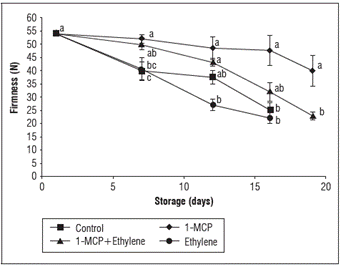
Figure 2 Effect of ethylene and 1-methylcyclopropene on the firmness of peach cv. Dorado fruits during storage. Means followed by different letters on the same sampling day showed statistically significant differences according to Tukey's test (P<0.05). Vertical bars on each mean indicate the standard error (n = 4).
The loss of firmness in a fruit may be related to an increase in the activity of enzymes that degrade the cell wall in peaches, such as polygalacturonase, pectin-methylesterase, endo-0-1,4-glucanase, a-arabinosidase and P-galactosidase. The activity of these enzymes may increase in the presence of ethylene because the depolymerization of pectins and xyloglucans is regulated by ethylene (Nishiyama et al., 2007; Pech et al., 2008) and it is expected to decrease as a result of the effect of 1-MCP, which blocks ethyl-ene activity at the cellular level; this suggests that, in peach cv. Dorado fruits, firmness may also be regulated by ethylene, even after the application of 1-MCP. Ozkaya et al. (2016) found a reduction in the activity of pectin methyl esterase and polygalacturonase in apricot fruits. Liu et al. (2015), in peach cv. Yahuala, and Wang et al. (2017), in peach cv. CN13, found that the application of 1-MCP increased firmness in comparison with non-treated fruits. Similarly, Khan and Singh (2007) found that 1-MCP delayed the loss of firmness in Prunus salicilina Lindl fruits by reducing the activity of polygalacturonase, pectin esterase and endo-1,4-d-glucanase, whereas Zhang et al. (2012), when using proteomics on peach fruits, found that 1-MCP decreased the loss of Ca ions, suppressed the degradation of the cell wall and maintained the mechanical properties of the cellular structure.
The color index (CI) of the skin increased with storage time. There were significant differences (P<0.05) between all treatments starting at day seven of storage. The changes were smaller in the fruits treated with 1-MCP (P<0.05), showing a CI of 2.63±0.59 at the end of the storage period. The fruits treated with ethylene showed a higher index color (3.87±0.48), despite the use of ethylene 7 d after 1-MCP; the control treatment showed a CI increase during storage (Fig. 3). Lelievre et al. (1997) stated that color changes may be dependent or independent of ethylene, as was later suggested by Dong et al. (2002), who observed changes in color independent of ethylene in Prunus armeniaca. However, these studies indicated that color in the peach cv. Dorado is dependent on ethylene; in fact, Barreto et al. (2017) found that, by applying ethylene to 'Chiripá' peach fruits, the color changed more than when applying 1-MCP.
The lower CI that resulted from the application of 1-MCP in the peach fruits may have been due to the fact that this compound delays color change since it can decrease chlorophyll degradation by reducing the activity of the chlorophyllase enzyme (Watkins, 2006; Sun et al., 2012), which is up-regulated by ethylene.
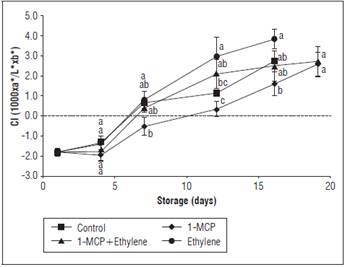
Figure 3 Effect of ethylene and 1-methylcyclopropene on color index (CI) of peach cv. Dorado fruits during storage. Means followed by different letters on the same sampling day showed statistically significant differences according to Tukey's test (P<0.05). Vertical bars on each mean indicate the standard error (n = 4).
The soluble solids (SS) increased gradually with storage. There were significant differences (P<0.05) between all sampling points. The fruits treated with 1-MCP accumulated less SS in every measurement, showing a value of 13.7±0.21 °Brix at the end of storage, whereas the fruits treated with ethylene, alone or in combination with 1-MCP, showed a higher concentration of SS (16.1±0.35 °Brix; Fig. 4).
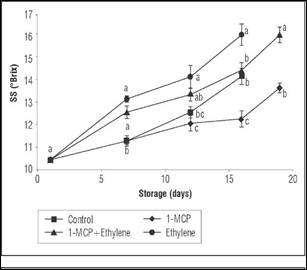
Figure 4 Effect of ethylene and 1-methylcyclopropene on soluble solids (SS) of peach cv. Dorado fruits during storage. Means followed by different letters on the same sampling day showed statistically significant differences according to Tukey's test (P<0.05). Vertical bars on each mean indicate the standard error (n = 4).
The higher concentration of SS at the end of storage may be explained by the hydrolysis of starch and polysaccharides in the cell wall (Kays and Paull, 2004); in peach cv. Dorado fruits, ethylene may play a role in accelerating hydrolysis processes, while 1-MCP may delay them, which supports the hypothesis that ethylene regulates a large part of peach fruit ripening in cv. Dorado. Likewise, Zhang et al. (2012) found that, in peach cv. Huiyulu, 1-MCP decreased starch degradation, decreasing the glycolytic metabolism and, therefore, ripening.
Our results agree with Barreto et al. (2017) who, in peach cv. Chiripá, found lower SS values for fruits treated with 1-MCP than for fruit treated with ethylene; on the contrary, Tonetto et al. (2007) and Steffens et al. (2009) did not observe any effect on SS after applying 1-MCP in the peaches 'Eldorado' and 'Roubidoux'.
The total acidity (TA) showed statistically significant differences (P<0.05) between all sampling points during storage, except at 19 DOS. For all treatments, there was a gradual decrease in acidity, which was higher for the ethylene and control treatments and lower for the 1-MCP treatment; at 19 DOS, the fruits with 1-MCP showed 0.95±0.11% TA (Fig. 5).
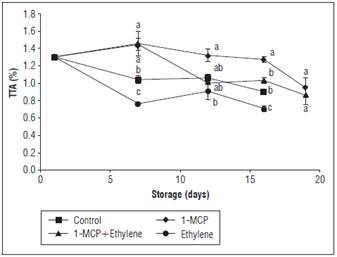
Figure 5 Effect of ethylene and 1-methylcyclopropene on total titratable acidity (TTA) of peach cv. Dorado fruits during storage. Means followed by different letters on the same sampling day showed statistically significant differences according to Tukey's test (P<0.05). Vertical bars on each mean indicate the standard error (n = 4).
According to Alves et al. (2009), the effect of 1-MCP on the TA of peach fruits may be explained by a lower acid consumption during the tricarboxylic acid cycle through the reduction of respiration. As observed in this study, TA decreases over the storage period because organic acids are part of the respiration substrates (Kays and Paull, 2004). Similar results have been shown by Barreto et al. (2017) in the peach, who found higher acidity in fruits treated with 1-MCP than in fruits treated with ethylene, which accelerates the loss of TA. Liu et al. (2015) also observed a higher TA with 1-MCP in peaches. On the contrary, Tonetto et al. (2007) did not observe effects from 1-MCP on the TA of the peach 'Eldorado', similar to Steffens et al. (2009) for the peach cv. Roubidoux. This suggests that the effect of 1-MCP on acidity depends on the cultivar, as indicated by Ligouri et al. (2004).
The maturity ratio (MR) increased gradually throughout storage and showed significant differences (P<0.05) between the treatments in all sampling points. The lowest values were found in the fruits treated with 1-MCP and with 1-MCP+ethylene, indicating a delay in MR (Fig. 6). The fruits treated with ethylene ripened faster, showing higher MR values over the storage period, which is a typical behavior for this variable, perhaps because of the increase in SS and decrease in TA (Ferrer et al., 2005; Africano et al., 2015). Accordingly, the exogenous application of ethylene accelerates ripening in peach cv. Dorado fruits, whereas 1-MCP delays it; however, Tonnetto et al. (2007) did not find any effect from 1-MCP on the MR of the peach 'Eldorado'.
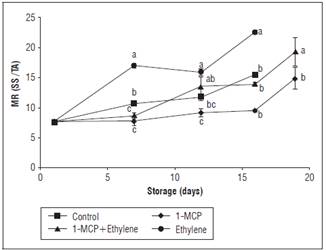
Figure 6 Effect of ethylene and 1-methylcyclopropene on maturity ratio (MR) of peach cv. Dorado fruits during storage. Means followed by different letters on the same sampling day showed statistically significant differences according to Tukey's test (P<0.05). Vertical bars on each mean indicate the standard error (n = 4).
CONCLUSIONS
Our results suggest that 1-MCP decreases the respiration rate, loss of firmness, epidermis color index, total soluble solids, total titratable acidity, and maturity ratio in the peach cv. Dorado, whereas ethylene has an opposite effect. Our results demonstrate that several ripening processes in peach cv. Dorado fruits are associated with the presence of ethylene and that 1-MCP may delay ripening throughout the storage of this fruit.















